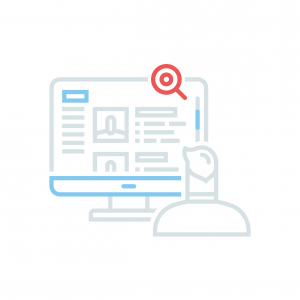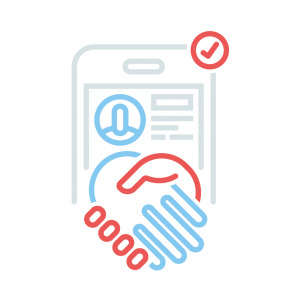
Video interviews have become increasingly common during the early stages of a selection process. In this article, we explain what to expect, with tips for preparation and performance to help you nail them.
Types of Interview
Video interviews may take the form of a one-way virtual interview, where the recruiter provides a list of questions and the candidate records their response. Or it can be a two-way live interview via video conferencing such as Skype, where you will have a proper conversation with someone (or several people) from a company i.e. closer to a traditional face-to-face interview.
Virtual/digital/one-way video interview
Virtual interviews are often one of the initial steps in screening job candidates. Similar to a phone interview, their purpose is to assess whether a candidate meets the requirements for the job and should proceed to the next round.
You will generally be asked to log in and answer a set of pre-recorded questions, by recording your responses on camera. There is often a time limit for responding (usually around 2 minutes). Some programs allow you a second chance to answer (if only that were true of live interviews!)
Recruiters may supply the questions in advance, with a deadline to submit your recording. (You’ll give a better impression if you don’t leave it until the last minute!) At this point of the selection process, you can expect to answer fairly standard interview questions about yourself, what you know about the company, why you want the job, why you would be suited etc. Make sure you prepare well, so you progress to the next stage.

Whilst you might feel more relaxed doing an interview in the comfort of your own home, video and particularly virtual interviews present their own set of challenges e.g. unfamiliarity, use of technology, impressing a blank screen, and coming across as an enthusiastic and all round great person in the absence of real human interaction!
In face-to-face interviews, alongside your suitability for a role, the employer will make a judgement on your potential fit with their team, depending on your personality and the vibe you give out. That’s not so easy via video, so how can you impress?
Follow our guide to nail your remote interview:
Tips for Video Interviews
Plan in advance
- Follow any instructions, paying particular attention to any time constraints and deadlines (for virtual interviews).
- Make sure you have all the necessary equipment (in working order).
- If you’re doing a live interview via Skype/Google Hangouts etc. make sure you have a professional username and check your privacy settings (or set up a new account).
- Some companies offer videos you can watch to familiarise yourself with the process, or a couple of practice sessions before you record your actual interview. So do check and take advantage of any aids or advice.
Do your research
Just as with any normal interview, proper preparation is key to success.
Research the role, company and industry. Understand the employer’s products/services, market and competitors, their recent performance, their vision, values and culture – know who they are and where they are going.
You’ll need to explain to the interviewer why you’re interested, what you can offer and why you would be a great fit.
What & where to research for job interviews
Prepare
Get organised. For a virtual interview, you may receive the questions in advance, which gives you a perfect opportunity to be well-prepared. But even if you don’t, you should anticipate questions and prepare clear, succinct responses, so you demonstrate good communication skills.
For competency-based questions, use the STAR Technique: Situation > Task > Action > Result:
Explain the situation facing you, what the task/challenge involved, the action you took, and the outcome (including measurable results if appropriate) and also what you learned from it.
Choose stories that illustrate attributes and achievements relevant to the role and company.
Think of 3 key points you want to get across about yourself.
In a two-way interview, prepare pertinent questions to ask e.g. about career development, company culture, next steps of the hiring process.
Tailor your application
How to use your research to tailor your application & persuade the employer that you are the best candidate for the role
Checklist of items for the interview day
- Log-in details and any instructions (read them carefully before you start).
- Your notes e.g. prepared answers – one great advantage of video interviews is you can have your notes handy, where only you can see them e.g. propped behind your laptop. (But don’t read from them, just practise your answers beforehand so they sound natural during the interview).
- Notepad and pen to jot down notes or work out answers, a calculator (if relevant) and any other equipment you need.
- Your CV, your initial application and the job description – ready for you to reference if necessary.
- Virtual interviews often have a time limit for recording answers; there may be an on-screen timer, but make sure you can easily see a clock just in case.
- A glass of water in case you dry up (which can happen when you’re nervous).

Dress to impress
Approach it as if you’re attending a real interview. Dress appropriately for the company culture, and if in doubt, err on the smart side. Tempting as it might be, don’t pair a jacket and tie with PJ bottoms! Dressing the part will put you in the right frame of mind – motivated and ready to impress.
Tip from an interviewer: avoid bright colours, loud patterns and plain white (on video, it can make you look washed out).
Sort the setting
Find a bright, quiet space with no distractions – no guest appearances from your pet labradoodle!
Think about what the interviewer can see behind you. Aim for a neutral wall or bookshelf (not an unmade bed or piles of clutter!)
Test the tech
Test your internet connection, mic and camera so you are not floored by technical hitches. Whatever the job, you need to show you’re tech savvy!
Close windows, tabs or applications on your computer that could interrupt the interview or slow your internet connection. And don’t forget to turn off your phone.
Get in the right headspace
While you’ll feel more relaxed being at home, you still need to mentally prepare yourself. Before the interview, take a quick walk in the fresh air for some valuable thinking time.
Try to be yourself
The recruiter will want to get a sense of who you are, to judge whether to put you forward to the next stage of the selection process. They do understand that virtual interviews can feel a bit awkward; it’s hard to impress a blank screen and you might feel like an idiot, but do smile and try to come across as a friendly person who will be good to have around.
Keep your mood upbeat and try to convey enthusiasm through facial expression and tone of voice, as well as what you say.
Good body language

You can’t impress with a firm handshake, but you can sit up straight and show confident body language.
As you’ll be aware, eye contact is very important when you’re meeting face-to-face; in video interviews, you can give the impression of eye contact by looking at the webcam, rather than at the computer image on your screen.
When you’re listening, nod and smile when appropriate to show that you’re paying attention.
Practise, practise, practise!
If you’re going to be timed, practise giving concise responses within the allotted time. If you go over, cut out parts that don’t directly answer the question.
Try a practice Skype interview with a friend/relative who will be honest about how you come across, and whether you can be seen and heard clearly.
Rehearse and record yourself on your laptop – you will soon spot anything that needs to be fixed! Practice will help you feel more comfortable in front of a screen and your confidence will grow.

Follow up immediately
After your interview, promptly fire off a short thank you email (within 24 hours). It shows that you value the employer’s time and the opportunity, and it gives you a chance to reaffirm your interest in the company and what you could bring to the role. Don’t worry too much about what to write, it’s the gesture that people will notice, one that might just help you progress to the next step…
The video interview format might vary, but your objective remains the same: Present the best version of you, by coming across as an enthusiastic decent person, having a sound knowledge of the role and company, and giving clear, concise responses that demonstrate why you would be a great fit.
Best of Luck! You can do it!
